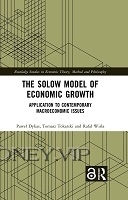
1 R. M. Solow’s inspirations
1.1 Introduction
Economic growth was first addressed by the classical school of economy
in the 18th century. In the years 1870–1945, studies were focused on effec-
tive allocation of limited resources, adopting a marginalist approach. Al-
most three decades after the Great Depression (1929–1933), discussions held
among macroeconomists centred on the causes, effects and assessments of
Keynesian responses to that series of events (Snowdon and Vane, 2000). The
question why is economic growth spatially differentiated (analyzed both
theoretically and empirically) became the leading research topic in econom-
ics of the second half of the 20th century. A majority of studies aimed to de-
velop the theory of endogenous growth. However, they were preceded by an
important event in the history of economic growth theories that occurred at
the dawn of the second half of that century: the publication of two break-
through papers by R.M. Solow (1956, 1957).
D. Romer (2012, p. 8) emphasized after almost 60 years that:
The Solow model is the starting point for almost all analyses of growth.
Even models that depart fundamentally from Solow’s are often best un-
derstood through comparison with the Solow model. Thus understand-
ing the model is essential to understanding theories of growth.
This is confirmed by the number of citations of both studies. It is almost
impossible to review all responses to the concepts proposed by R.M. Solow
(1956, 1957) that were published until today.
Hence, this chapter is aimed to concisely describe selected scientific inspira-
tions that led to the development of the growth model in its versions proposed
in 1956 and 1957. In his Nobel-prize lecture (Lecture to the memory of Alfred
Nobel, December 8, 1987), R.M. Solow emphasized: “(…) in the 1950s I was
following a trail that had been marked out by Roy Harrod and by Evsey Do-
mar (…)” (see also: Solow, 1988), and in Addendum (August, 2001), he added:
Another, much less prominent, line of thought may be worth mention-
ing. It goes back to the 1950s when Nicholas Kaldor tried to produce a
coherent growth model based entirely on relationships among rates of
growth, conspicuously without any explicit function relating inputs and
outputs.
1.2 Harrod’s equilibrium
Harrod’s equilibrium analysis was based on three assumptions (1936, p. 33;
1939, p. 14):
1 Saving is proportional to national income, St = sYt; the level of a com-
munity’s income is the most important determinant of its supply of
saving,
2 Investment, the demand for saving, is proportional to the growth of na-
tional income, It = g(Yt+1 − Yt); the rate of increase of its income is an
important determinant of its demand for saving, and
3 Saving equals investment, the demand for saving equals the supply of
saving, St = It.
From this, one derives the “fundamental equation” of equilibrium:




